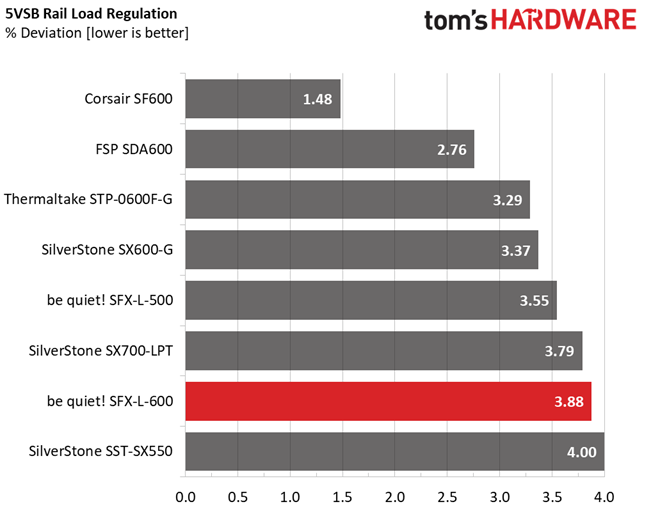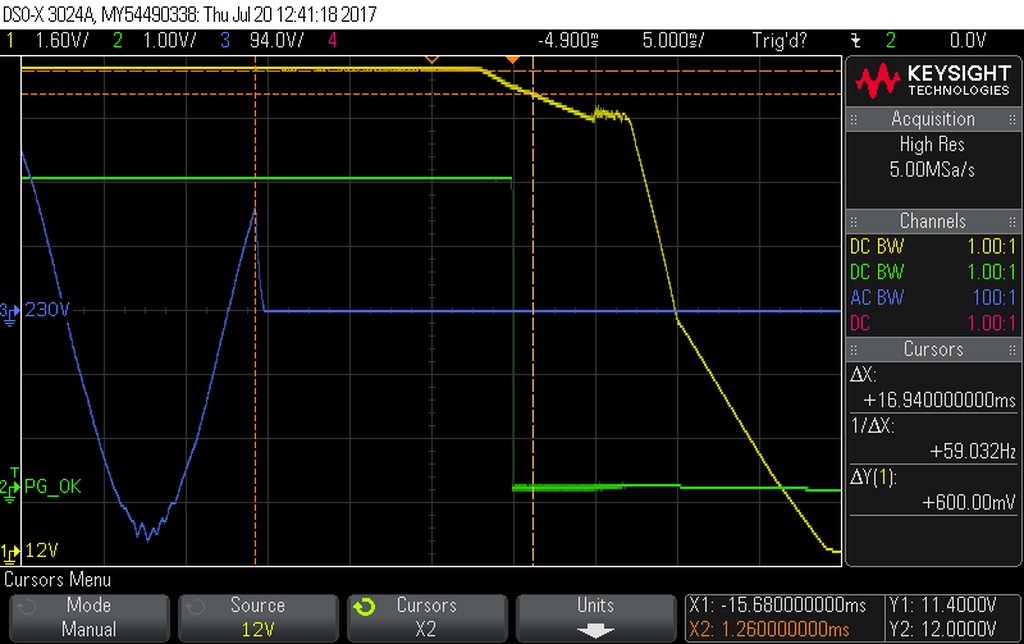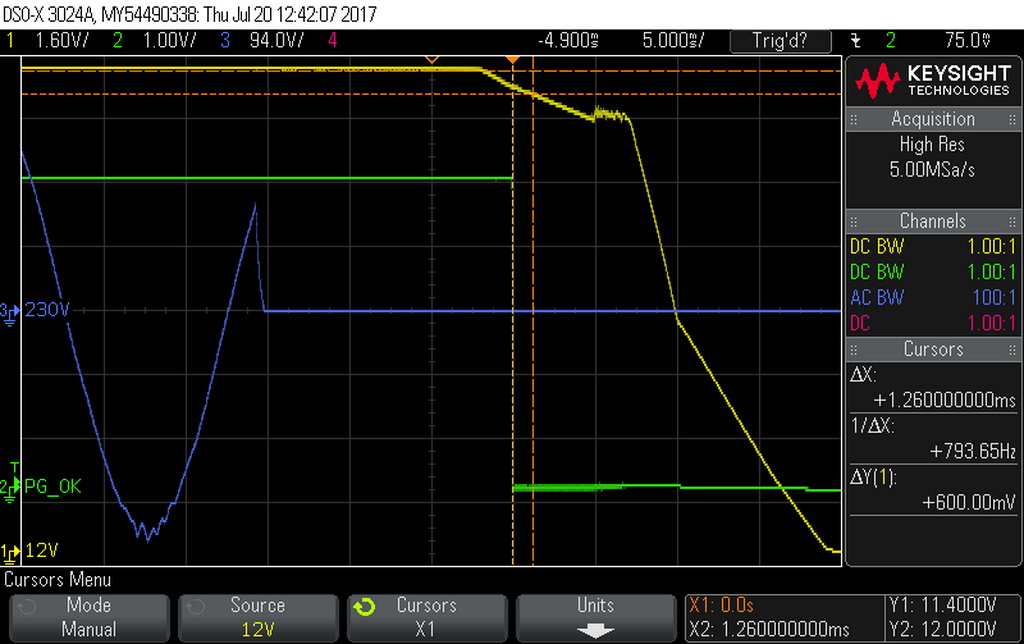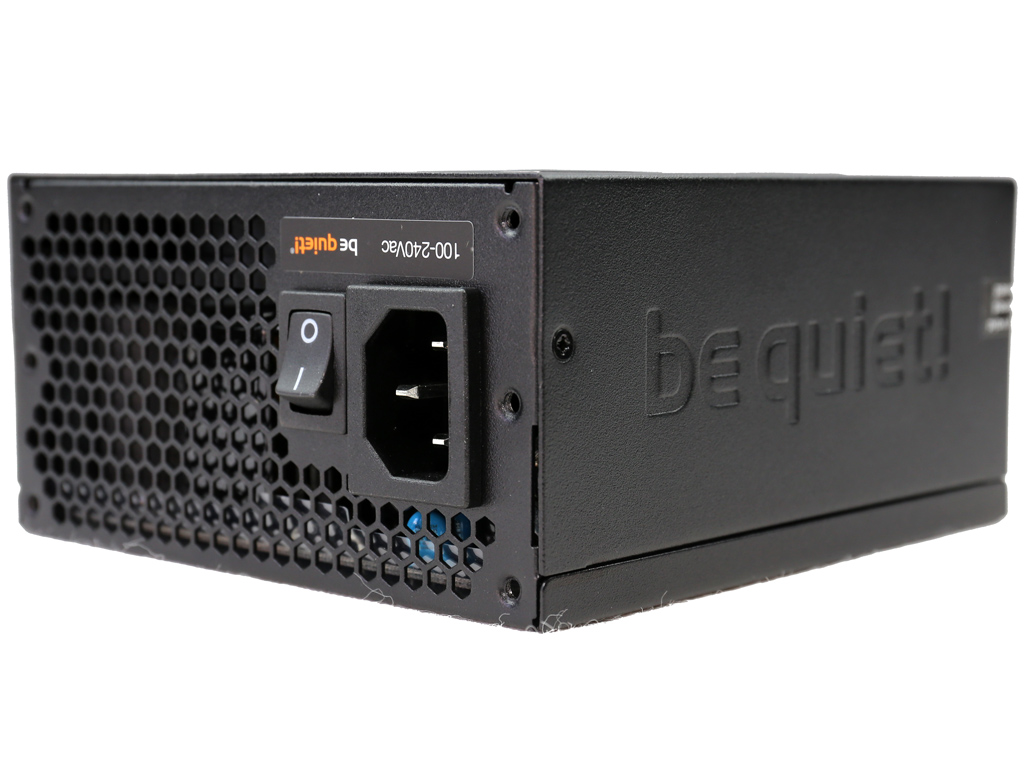be quiet! SFX L Power 600W PSU Review
Why you can trust Tom's Hardware
Load Regulation, Hold-Up Time & Inrush Current
To learn more about our PSU tests and methodology, please check out How We Test Power Supply Units.
Primary Rails And 5VSB Load Regulation
Load Regulation testing is detailed here.








Hold-Up Time
Our hold-up time tests are described in detail here.







The hold-up time is right where it should be. And although the power-good signal is a little shorter than the ATX spec's recommendation, it's still accurate, which is what matters most.
Inrush Current
For details on our inrush current testing, please click here.


The lack of an NTC thermistor leads to very high inrush currents. High Power should make the necessary changes to this platform as soon as possible!
Load Regulation And Efficiency Measurements
The first set of tests reveals the stability of the voltage rails and the SFX L Power 600W's efficiency. The applied load equals (approximately) 10 to 110 percent of the PSU's maximum load in increments of 10 percentage points.
Get Tom's Hardware's best news and in-depth reviews, straight to your inbox.
We conducted two additional tests. During the first, we stressed the two minor rails (5V and 3.3V) with a high load, while the load at +12V was only 0.1A. This test reveals whether a PSU is compatible with Intel's C6/C7 sleep states or not. In the second test, we determined the maximum load the +12V rail could handle with minimal load on the minor rails.
| Test # | 12V | 5V | 3.3V | 5VSB | DC/AC (Watts) | Efficiency | Fan Speed | Fan Noise | Temps (In/Out) | PF/AC Volts |
|---|---|---|---|---|---|---|---|---|---|---|
| 1 | 3.117A | 1.974A | 1.954A | 0.996A | 59.787 | 83.863% | 1400 RPM | 27.3 dB(A) | 38.14°C | 0.972 |
| 12.261V | 5.056V | 3.374V | 5.016V | 71.291 | 40.25°C | 115.17V | ||||
| 2 | 7.260A | 2.968A | 2.938A | 1.199A | 119.813 | 88.488% | 1435 RPM | 28.6 dB(A) | 38.70°C | 0.992 |
| 12.252V | 5.047V | 3.366V | 5.000V | 135.401 | 40.95°C | 115.16V | ||||
| 3 | 11.752A | 3.478A | 3.446A | 1.400A | 179.885 | 89.971% | 1455 RPM | 29.5 dB(A) | 38.95°C | 0.995 |
| 12.237V | 5.038V | 3.359V | 4.985V | 199.937 | 41.57°C | 115.16V | ||||
| 4 | 16.250A | 3.975A | 3.935A | 1.607A | 239.761 | 90.528% | 1550 RPM | 30.2 dB(A) | 39.17°C | 0.997 |
| 12.221V | 5.030V | 3.352V | 4.970V | 264.847 | 42.18°C | 115.16V | ||||
| 5 | 20.419A | 4.980A | 4.932A | 1.816A | 299.775 | 90.480% | 1560 RPM | 30.4 dB(A) | 39.79°C | 0.998 |
| 12.209V | 5.019V | 3.343V | 4.955V | 331.318 | 43.12°C | 115.16V | ||||
| 6 | 24.585A | 5.987A | 5.931A | 2.020A | 359.735 | 90.148% | 1610 RPM | 31.3 dB(A) | 40.24°C | 0.998 |
| 12.202V | 5.009V | 3.335V | 4.940V | 399.048 | 44.15°C | 115.16V | ||||
| 7 | 28.755A | 7.009A | 6.939A | 2.231A | 419.741 | 89.657% | 1655 RPM | 32.2 dB(A) | 41.27°C | 0.999 |
| 12.194V | 4.999V | 3.326V | 4.924V | 468.164 | 45.71°C | 115.16V | ||||
| 8 | 32.928A | 8.023A | 7.956A | 2.445A | 479.674 | 89.069% | 1765 RPM | 34.2 dB(A) | 42.46°C | 0.999 |
| 12.186V | 4.988V | 3.318V | 4.906V | 538.541 | 47.53°C | 115.16V | ||||
| 9 | 37.532A | 8.534A | 8.484A | 2.445A | 539.710 | 88.458% | 1830 RPM | 34.9 dB(A) | 43.70°C | 0.999 |
| 12.180V | 4.980V | 3.311V | 4.900V | 610.130 | 49.77°C | 115.16V | ||||
| 10 | 41.890A | 9.063A | 8.995A | 3.084A | 599.662 | 87.718% | 1860 RPM | 35.4 dB(A) | 44.83°C | 0.999 |
| 12.173V | 4.970V | 3.302V | 4.861V | 683.621 | 51.84°C | 115.17V | ||||
| 11 | 46.829A | 9.071A | 9.014A | 3.090A | 659.593 | 86.965% | 1870 RPM | 35.6 dB(A) | 46.07°C | 0.999 |
| 12.169V | 4.964V | 3.296V | 4.852V | 758.455 | 53.81°C | 115.16V | ||||
| CL1 | 0.098A | 13.019A | 13.003A | 0.004A | 110.018 | 81.865% | 1790 RPM | 34.5 dB(A) | 44.20°C | 0.993 |
| 12.239V | 5.011V | 3.350V | 5.072V | 134.390 | 50.75°C | 115.17V | ||||
| CL2 | 49.948A | 1.005A | 1.002A | 1.002A | 622.143 | 88.269% | 1850 RPM | 35.2 dB(A) | 44.58°C | 0.999 |
| 12.189V | 5.002V | 3.323V | 4.960V | 704.829 | 51.54°C | 115.17V |
Load regulation on every rail except for 5VSB is pretty tight, and the PSU has no problem delivering more than its full power at high ambient temperatures.
That FDB fan spins quickly throughout our benchmark session, but its noise output isn't annoying, even during the full load and overload tests. Moreover, the SFX L Power 600W satisfies the 80 PLUS Gold efficiency requirements, despite our elevated ambient temperatures. Finally, we notice high power factor readings, meaning less energy goes wasted.
MORE: Best Power Supplies
MORE: How We Test Power Supplies
MORE: All Power Supply Content
Current page: Load Regulation, Hold-Up Time & Inrush Current
Prev Page Teardown & Component Analysis Next Page Efficiency, Temperature & Noise
Aris Mpitziopoulos is a contributing editor at Tom's Hardware, covering PSUs.
-
Aris_Mp The SF600 has higher performance. This is shown in the relative performance chart. However in the overall noise score the SF600 is much higher as well, because its fan profile gets highly aggressive once you load its minor rails. In real life conditions where the minor rails are lightly used, it is quite silent.Reply -
expert_vision You know what baffles me? How is it possible that no monitoring is offered in today PSUs ? I used to have a HighPower PSU 10 years ago that had a simple 7 segment display, showing instantaneous power draw in watts, and a 3 header pin for FAN RPM. You'd think by today that would be standard. But no, instead they put freaking RGB in everything ...Reply -
below I had bought one of them a few weeks ago and after installing in bitfenix portal case it has start to randomly make noises. I had rebuild my block two times just to make sure that there is nothing except PSU fan itself making that noise. The noise is comparably with very old HDD's or even Floppy crunching, its super annoying and only appears in PSU working state (when fan at the bottom) and mostly on high load, also noise could be very loudReply
Also I have found some review on Spanish (I think) from amazon about this PSU and customer have exactly the same issue, so looks like it could be design problem.
This PSU is a winner of most comparisons an reviews everywhere and I very dissapointed that none of reviewers couldn't find such awfull issue for quiet PSU.
Also it should be a shame for company named 'be quiet' that it's 'silent wings' in that PSU making that horrible noises.


